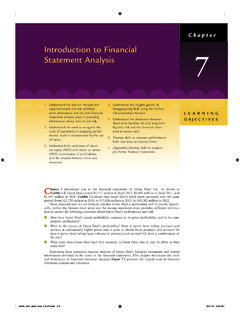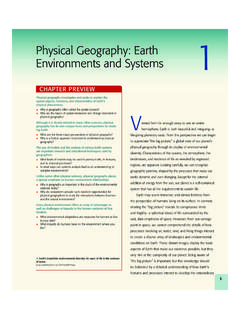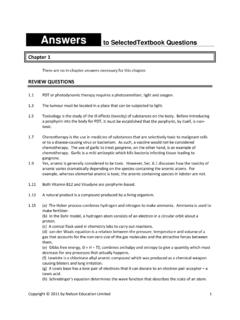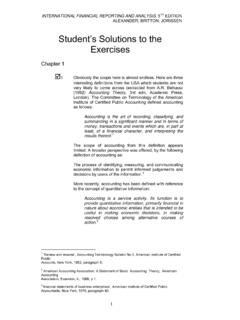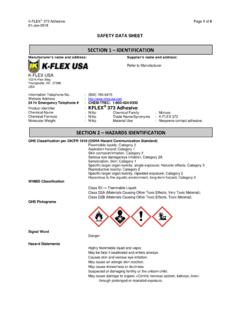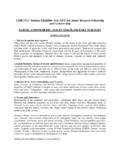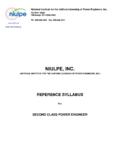Transcription of Atmospheric Pressure, Winds, and Circulation …
1 113 Atmospheric Pressure, Winds, and Circulation Patterns A n individual gas molecule weighs almost nothing; however, the atmosphere as a whole has considerable weight and exerts an average pressure of 1034 grams per square centimeter ( lb/sq in.) on Earth s surface. The reason why people are not crushed by this Atmospheric pressure is that we have air and water inside us in our blood, tissues, and cells exerting an equal outward pressure that balances the inward pressure of the atmosphere. Atmospheric pressure is important because variation in pressure within the Earth atmosphere system creates our Atmospheric Circulation and thus plays a major role in determining our weather and climate. It is the differences in Atmospheric pressure that create our winds. Further, the movement of the winds drives our ocean currents, and thus Atmospheric pressure works its way into several of Earth s 1643, Evangelista Torricelli, a student of Galileo, performed an experiment that was the basis for the invention of the mercury barometer, an instrument that measures Atmospheric (also called barometric) pressure.
2 Torricelli took a tube filled with mercury and inverted it in an open pan of mercury. The mercury inside the tube fell until it was at a height of about 76 centimeters ( in.)Latitudinal differences in temperature (as a result of differential receipt of insolation) provide a partial explanation for latitudinal differences in is the relationship between temperature and pressure?Why is this only a partial explanation?The fact that land heats and cools more rapidly than water is of signifi cance not only to world patterns of temperature but also to world patterns of pressure, winds, and can you explain this fact?What effect does this fact have on world patterns?Planetary (global) wind systems in association with global pres-sure patterns play a major role in global are the six major planetary (global) wind belts or zones, and what are their chief characteristics?Why do the wind belts migrate with the seasons?Upper air winds and Atmospheric Circulation play a major role in controlling surface weather and climatic is upper air Circulation like?
3 How do ocean currents affect Atmospheric conditions of land areas?El Ni os can have a devastating impact on our global is an El Ni o?How does it infl uence global weather? Opposite: The swirling Circulation patterns seen in Earth s atmosphere are created by changes in pressure and 5 CHAPTER PREVIEW 55061_05_Ch05_p112_139 11355061_05_Ch05_p112_139 1136/5/08 11:18:34 PM6/5/08 11:18:34 PMCHAPTER 5 Atmospheric PRESSURE, WINDS, AND Circulation PATTERNS114above the mercury in the pan, leaving a vacuum bubble at the closed end of the tube ( Fig. ). At this point, the pressure exerted by the atmosphere on the open pan of mercury was equal to the pressure from the mercury trying to drain from the tube. Torricelli observed that as the air pressure increased, it pushed the mercury up higher into the tube, increasing the height of the mercury until the pressure exerted by the mercury (under the pull of gravity) would equal the pressure of the air. On the other hand, as the air pressure decreased, the mercury level in the col-umn dropped.
4 In the strictest sense, a mercury barometer does not actually measure the pressure exerted by the atmosphere on Earth s sur-face, but instead measures the response to that pressure. That is, when the atmosphere exerts a specific pressure, the mercury will respond by rising to a specific height ( Fig. ). Meteorolo-gists usually prefer to work with actual pressure units. The unit most often used is the millibar (mb). Standard sea-level pressure of millibars will cause the mercury to rise 76 centimeters ( in.).Our study of the Atmospheric elements that combine to produce weather and climate has to this point focused on the fundamental influence of solar energy on the global distribu-tional patterns of temperature. The unequal receipt of insolation by latitude over Earth s surface produces temperature patterns that vary from the equator to the poles. In this chapter, we learn that these temperature differences are one of the major causes of the development of patterns of higher and lower pressure that also vary with latitude.
5 In addition, we examine patterns of another kind patterns of movement or, more properly, Circulation , in which both energy and matter travel cyclically through Earth are particularly interested in Circulation pat-terns because they illustrate spatial interaction, one of geography s major themes introduced in Chapter 1. Patterns of movement between one place and another reveal that the two places have a relationship and prompt geographers to seek both the nature and effect of that relationship. It is also important to understand the causes of the spatial interaction taking place. As we examine the Circulation patterns featured later in this chapter, you should make a special effort once again to trace each pattern back to the fundamental influence of solar 76 cm in 1013 mb Air pressure Mercury Air pressure FIGURE simple mercury barometer. Standard sea-level pressure of milli-bars will cause the mercury to rise 76 centimeters ( in.) in the air pressure increases, what happens to the mercury in the tube?
6 FIGURE mercury barometer is bolted to the wall of the College Heights Weather Station in Bowling Green, must this instrument be so tall to work properly? Scott Dobler 55061_05_Ch05_p112_139 11455061_05_Ch05_p112_139 1146/5/08 11:18:35 PM6/5/08 11:18:35 PM115 Variations in Atmospheric PressureVertical Variations in PressureImagine a pileup of football players during a game. The player on the bottom gets squeezed more than a player near the top because he has the weight of all the others on top of him. Similarly, air pressure decreases with elevation, for the higher we go, the more diffused, and more widely spaced the air molecules become. The increased intermolecular space results in lower air density and lower air pressure ( Fig. ). In fact, at the top of Mount Everest (elevation 8848 m, or 29,028 ft), the air pressure is only about one third the pressure at sea are usually not sensitive to small, everyday variations in air pressure. However, when we climb or fly to altitudes signifi-cantly above sea level, we become aware of the effects of air pressure on our system.
7 When jet aircraft fly at 10,000 meters (33,000 ft), they have to be pressurized and nearly airtight so that a near- sea-level pressure can be maintained. Even then, the pressuriza-tion may not work perfectly, so our ears may pop as they adjust to a rapid change in pressure when ascending or descending. Hiking or skiing at heights that are a few thousand meters in elevation will affect us if we are used to the air pressure at sea level. The re-duced air pressure means less oxygen is contained in each breath of air. Thus, we sometimes find that we get out of breath far more easily at high elevations until our bodies adjust to the reduced air pressure and corresponding drop in oxygen in air pressure are not solely related to altitude. At Earth s surface, small but important variations in pressure are re-lated to the intensity of insolation, the general movement of global Circulation , and local humidity and precipitation. Consequently, a change in air pressure at a given locality often indicates a change in the weather.
8 Weather systems themselves can be classified by the structure and tendency toward change of their Variations in PressureThe causes of horizontal variation in air pressure are grouped into two types: thermal (determined by temperature) and dynamic (related to motion of the atmosphere).We look at the simpler thermal type first. In Chapter 4, we saw that Earth is heated unevenly because of unequal distribu-tion of insolation, differential heating of land and water surfaces, and different albedos of surfaces. One of the basic laws of gases is that the pressure and density of a given gas vary inversely with temperature. Thus, during the day, as Earth s surface heats the air in contact with it, the air expands in volume and decreases in density. Such air has a tendency to rise as its density decreases. When the warmed air rises, there is less air near the surface, with a consequent decrease in surface pressure. The equator is an area where such low pressure occurs an area with cold air, there is an increase in density and a decrease in volume.
9 This causes the air to sink and pressure to in-crease. The poles are areas where such high pressures occur regu-larly. Thus, the constant low pressure in the equatorial zone and the high pressure at the poles are thermally this we might expect a gradual increase in pressure from the equator to the poles to accompany the gradual decrease in average annual temperature. However, actual readings taken at Earth s surface indicate that pressure does not increase in a regu-lar fashion poleward from the equator. Instead, there are regions of high pressure in the subtropics and regions of low pressure in the subpolar regions. The dynamic causes of these zones, or belts, of high and low pressure are more complex than the ther-mal dynamic causes are related to the rotation of Earth and the broad patterns of Circulation . For example, as air rises steadily at the equator, it moves toward the poles. Earth s rotation, how-ever, causes the poleward-flowing air to drift to the east. In fact, by the time it is over the subtropical regions, the air is flowing from west to east.
10 This bending of the flow as it moves poleward impedes the northward movement and causes the air to pile up over the subtropics, which results in increased pressure at Earth s surface high pressure over the polar and subtropical regions, dynamically induced areas of low pressure are created between them, in the subpolar region. As a result, air sinks into and flows from the highs to the lows, where it enters and rises. Thus, both the subtropical and subpolar pressure regions are dynamically in-duced. This example describes horizontal pressure variations on a global scale. We concentrate on this scale later in this chapter. FIGURE air pressure and air density decrease rapidly with increasing approximately how much does density drop between 0 and 100 km?Altitude (km)Air densityAir moleculesAirpressureIncreasing1000 LowHigh300200400500 VARIATIONS IN Atmospheric PRESSURE55061_05_Ch05_p112_139 11555061_05_Ch05_p112_139 1156/5/08 11:18:36 PM6/5/08 11:18:36 PMCHAPTER 5 Atmospheric PRESSURE, WINDS, AND Circulation PATTERNS116 Basic Pressure SystemsBefore we begin our discussion of Circulation patterns leading up to the global scale, we must start by describing the two basic types of pressure systems: the low, or cyclone, and the high, or anti-cyclone.
